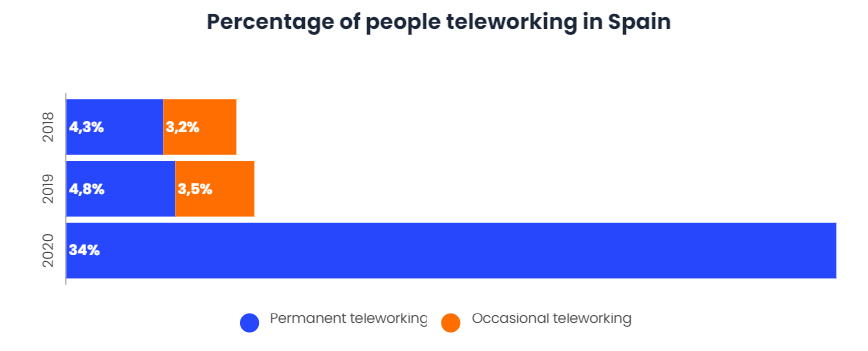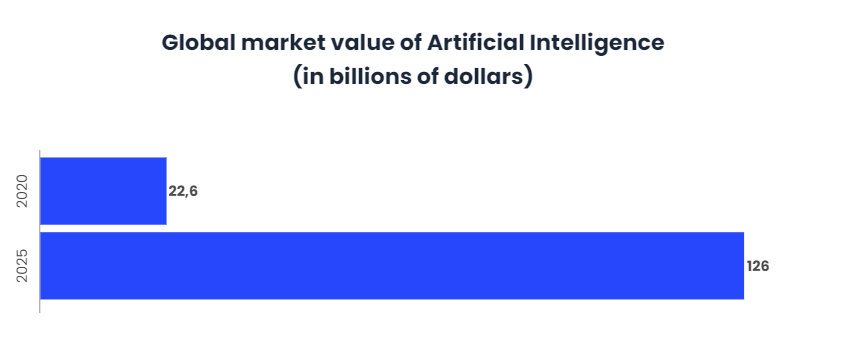Technology, the real winner of the Post-Covid era

The COVID-19 crisis has affected societies and economies around the world and will permanently reshape the world as it continues to develop. While the consequences of the crisis amplify existing risks and create new ones, change on this scale also creates new opportunities to manage challenges.
One such opportunity has undoubtedly been that of digital adoption. The increased use of technology, for virtually everything and accelerated by the impact of the pandemic, has created new digital habits. Companies must adapt by implementing the changes and transforming themselves digitally to meet the new expectations that are emerging.
The boost for digitisation
Today, the full extent of the impact of the pandemic at the personal, economic and business levels is still unknown. But what is known is that with its arrival the need for innovation has accelerated.
This Covid-19 crisis has made it clear that technology can be an important pillar for the survival of many companies, playing a great role to the extent that digitally transformed companies are those that have best survived this crisis, being able to continue their activity or mitigate the impact.
In just a few months the Covid-19 has accelerated the digital technologies that have been there for a long time, but which until now many companies did not even know existed. The virtual is replacing the physical everywhere: medical centres, hospitals, offices of large and small businesses, meeting places and entertainment, etc., in fact, more than 30% of visits to doctors will be made by telecare even after the pandemic.
But the health sector will not be the only one to continue to maintain, even after the pandemic, digital technologies, eCommerce, assistive robots or teleworking will continue to spread. And is that companies have been able to see how technology and entrepreneurship has been the salvation for many companies.
Technology will be the key in a post-covid world
Many companies have seen with their own eyes how technology was the only way for their company to survive and stay afloat. Companies that before the pandemic refused to use this technology, with the Covid-19 have been forced to innovate and have been able to see that it works.
Furthermore, they have managed to understand that this digital transformation is going to be necessary to ensure that companies and countries remain competent in a post-Covid world, as it is increasingly impossible to return to the situation that existed before the pandemic.
The arrival of Covid-19 has accelerated many of the trends that were already in place before the pandemic, especially those that allowed the reduction or elimination of contact between people. Robots in hotels to serve tourists, the use of smartphones to place orders in restaurants, self-service kiosks that are activated by voice, or lifts with holographic buttons, are some of the technological innovations being worked on to address the new situation after the Covid-19.
Teleworking is here to stay
Telework has been one of those trends that was not widespread before the pandemic, although it was growing over the years. Few companies had established it in part or in the whole of their workforce. For example, in Spain, by 2019 the percentage of people working from home on a continuous basis increased from 4.3 per cent to 4.8 per cent, and the percentage of those working occasionally increased from 3.2 per cent to 3.5 per cent.

This scenario has changed completely in recent months with the arrival of the pandemic, as companies were forced to introduce this type of work. During the weeks of confinement the percentage of people teleworking grew to 34%.
After the weeks of confinement and the return to “normality”, many companies have been able to verify that their companies are functioning perfectly with their workers relocated, and therefore many have decided either to implement this modality definitively or to make the form of work more flexible.
The large number of tool, application and software options available for the implementation of teleworking has meant that this trend has been the protagonist in recent months. The demand for videoconference and video call tools has shot up in order to be able to carry out meetings and classes online. In fact, the use of this type of application has grown by 129% worldwide.
With teleworking comes also the increase in the use of management and task control tools, as this working method forces people to organise themselves better, to communicate clearly and to find other options to be able to manage and plan team tasks better online.
Another tool that has increased exponentially thanks to the implementation of teleworking has been collaboration software. Office tools that allow people to work collaboratively on documents or presentations and online whiteboards are more valuable than ever.
Cloud investments don’t stop
This trend was already on the rise before confinement, but the almost complete elimination of paper use, online schooling and teleworking has made cloud systems essential tools for managing and organising company information securely.
In fact, according to data provided by Microsoft, during the Covid-19 crisis there was a 775% increase in demand for its cloud services. And this upward trend does not seem to stop here, as everything points to the fact that this type of technology will continue to grow in any type of application, and will be a major player in the post-Covid era. In fact, 8 out of 10 companies believe that the cloud can help companies recover after Covid-19 and that it will be a key trend in getting out of this situation. Furthermore, companies say that their investments in both IaaS/PaaS and SaaS will also increase over the coming year.
The rise of online commerce (e-Commerce)
Another of the great changes brought about by this pandemic is that of consumer behaviour and the rise of new online consumer trends and habits. With the advent of confinement the percentage of people who began to buy online, as well as the percentage of companies that made their products available for purchase over the internet, grew exponentially, and many of these new consumer habits have come to stay in the post-Covid stage.
This pandemic has triggered Internet purchases reaching historic highs despite the possible difficulties these online channels had in responding to customer demands, and companies of all sizes have been able to see and verify that the future lies in omnicanality, that is, in the use of both physical and digital channels for the sale of their products and services. This trend has led many companies to discover another way of generating new income, and in the post-Covid stage these companies will reinforce their online strategies.
A clear example has been the traditional business of selling fresh fish. Many small businesses have managed to stay afloat thanks to the sale of this product on the Internet. La Lonja de Almería, for example, has shot up sales of fresh fish over the internet by 600%, 80 orders a day.
Artificial Intelligence
Artificial Intelligence has already been introduced in many sectors such as mobility, education, manufacturing, e-commerce, communications, health, insurance, finance and many others.
During the pandemic, the benefits of AI as a crisis management tool have been more than demonstrated. For example, with the help of AI, it was possible to identify patterns from Big Data, predict human behaviour and image and voice recognition, support health systems and control the spread of the virus through tracking software. AI systems can learn on their own and adapt continuously, and these capabilities will be especially valuable as companies adapt and cope with the new post-Covid era.
In fact, the global market value of AI will increase from $22.6 billion in 2020 to $126 billion in 2025. With this it can be seen clearly that the pandemic has driven, and will continue to drive, the improvement and development of AI and automation.

In addition, this current situation is driving the development of robots and the improvement of AI to save lives and reduce human exposure to the virus. This could lead to a new era of robotic assistants. In fact, many companies are promoting this collaboration between humans and AI, and the benefits of this collaboration have never been more important. The most obvious example of this collaboration is the search for a vaccine against Covid-19.
Virtual and Augmented Reality
Another trend that has triggered the Covid-19 has been Virtual Reality and Augmented Reality, especially among younger people. This pandemic has seen the use of this technology in video games, virtual tourism, concerts, theatres, and in online entertainment programs in general.
Both individuals and companies have used virtual reality platforms to cover their social needs, for example, to hold meetings, conferences, collaborations, training, etc.
With the pandemic, the possibilities of this technology have been seen, but it is considered to be even more important in the post-Covid-19 era:
- Virtual Reality in marketing: This crisis has forced many companies to reinvent themselves and to do so, investment in marketing has been more important than ever in order to optimise sales and improve the company’s image. To achieve this, Virtual Reality technology has been used, in the form of virtual catalogues, product demonstrations, etc.
- Virtual Reality Simulations: The use of Virtual Reality in simulators helps to better understand the behaviour of a specific element under study when faced with a specific event. Already during the Covid-19, Virtual Reality simulations have proved to be a key element in improving the quality of studies of virus spread in closed environments, such as inside the cabin of an aircraft, a vehicle, a room …
- Virtual Reality in communications: The use of Virtual Reality to communicate will offer greater immersion, also improving the user experience and offering greater proximity.
- Virtual Reality in training: The use of Virtual Reality to carry out training has already had many benefits, such as saving on both structural and logistical costs, saving on people’s mobility, making it easier to update content, etc. But now, in addition to all these benefits, Virtual Reality reduces social contact, as each person could even carry out the training from home, and increases security by allowing the safety distance to be maintained.
- Virtual Reality in entertainment: Virtual Reality adds extra value to the way multimedia entertainment is consumed: interaction. This is a new concept of entertainment, which offers new opportunities. Concerts enjoyed from home, travelling to other countries and cities without leaving home, visiting museums, attending plays… are some examples.
The acceleration of 5G
It is estimated that the implementation of 5G networks will take place between 2020 and 2030, making downloads and uploads five times faster than with 4G networks. But with the arrival of the Covid-19 everything seems to indicate that 5G networks will arrive earlier than expected.
This is mainly due to the fact that with the confinement people had to isolate themselves, which greatly increased all the burden the networks have had to bear, in addition to the increased demand for bandwidth. This has highlighted the need for much faster connectivity, and 5G could well meet those capacity and bandwidth needs.
The growth of the Internet of Things
The Internet of Things is becoming a very important tool in the fight against Covid-19, since it allows to predict and tackle health problems, can help identify symptoms, monitor patients and save all data to help researchers and the government to prevent.
This technology has been seen in smart thermometers that stored data on users’ temperatures, and with that data maps were created. Also smart rings whose temperature sensors could detect early signs of Covid-19. On the streets, smart cameras have been able to monitor the safety distance in public spaces, smart hand sanitizer dispensers have also been installed, and much more.
With the arrival of the pandemic more and more people are accepting the arrival and use of such devices as part of their lives, and many even accept the sharing of their health data. However, in the future we must be careful with this, because just as there are people who accept it, there are also people who are afraid about the privacy of their data and where it might be used.
Companies should take this into account and try to find ways to alleviate these kinds of concerns.
The support of the Blockchain
The Blockchain technology has also played a very important role in the fight against Covid-19, serving as a support to many initiatives around the world in order to fight the virus:
One of these initiatives has been the tracking and monitoring of disease data. Because of its transparency it can provide more efficient and accurate information responses. The use of this technology has also been seen in the development of drugs to combat the virus, as due to its rapid data processing, symptoms can be detected before the disease spreads.
In addition, with the use of smart contracts, government organizations can issue immediate health communications and alerts to the population. And by benefiting from the effectiveness of this tool in managing supply chains in any sector, it has been possible to keep track of health products.
Cybersecurity more important than ever
In recent years, cyber security has been a priority for many companies. With the isolation of people in their homes and the implementation of teleworking, companies that had not invested much in cyber security were forced to do so, adopting emergency measures and implementing security measures. This situation became a challenge for these companies.
The cybercriminals took advantage of this situation of uncertainty and fear among the population to spread their own viruses. Thus, these months have seen fake Covid-19 domains, fraudulent email campaigns, an upsurge in ransomware attacks, etc.
This is why cyber security has become more important than ever as companies are more at risk.
Conclusions
While the end of this health crisis is not yet known, it is important for companies, governments and even individuals to prepare for a more digital future through partnerships and the implementation of technologies that will bring more value to business.
With the arrival of this health crisis, it has been possible to see that technology has, on many occasions, been key to the survival of many companies, allowing them to maintain activity, and even increasing their visibility.
The Covid-19 has accelerated the digital transformation and riding the wave will be key for companies to remain competent and their income levels will also continue to be maintained. And although after the pandemic much of the economy will return to the structure it had before, many others will change forever, and this is why it will be necessary for companies to adapt to the new business panorama and the new economic reality that is about to come.


